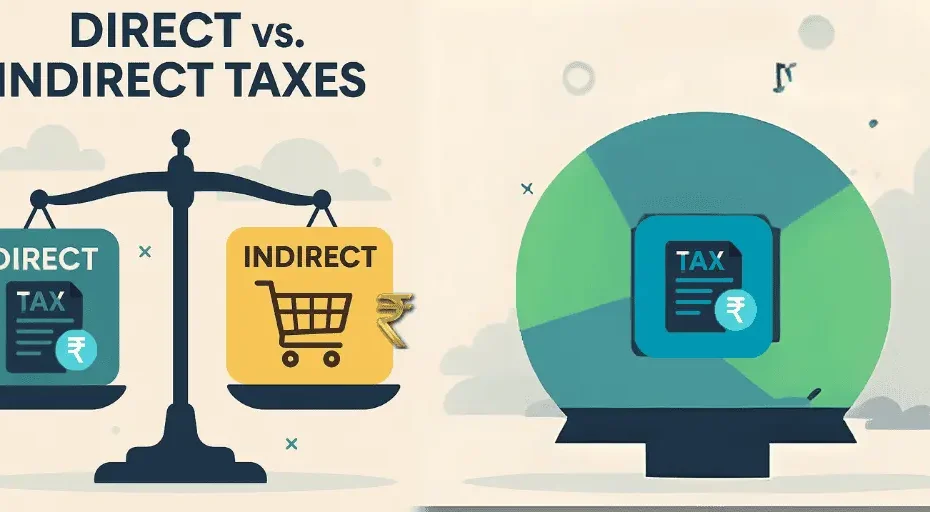Direct vs Indirect Taxes: Key Differences Explained
Taxation is an essential component of any economy, serving as a primary source of revenue for governments. Taxes fund public services, infrastructure, healthcare, and education, ensuring the smooth functioning of a nation. Broadly, taxes are classified into two categories: direct vs indirect taxes. Understanding these two forms of taxation is crucial for individuals, businesses, and policymakers.
This article will explore the fundamental differences between direct vs indirect taxes, their advantages, disadvantages, and real-world applications.
What Are Direct Taxes?
A direct tax is imposed directly on an individual or entity and is paid directly to the government. These taxes are non-transferable, meaning the taxpayer cannot pass the burden onto someone else. The amount of direct tax paid is often based on income, property value, or corporate profits.
Examples of Direct Taxes:
Income Tax: Individuals and corporations pay a percentage of their earnings as tax.
Corporate Tax: Businesses pay taxes on their profits.
Property Tax: Homeowners pay taxes based on the value of their property.
Wealth Tax: Some governments impose taxes on an individual’s net worth.
Advantages of Direct Taxes:
Equity: Higher earners pay more, ensuring a fair distribution of the tax burden.
Certainty: Taxpayers know how much they owe based on predefined rates.
Government Revenue Stability: Direct taxes provide a steady stream of income for the government.
Disadvantages of Direct Taxes:
Tax Evasion: Some individuals and businesses hide income to avoid paying taxes.
Administrative Burden: Direct taxes require complex documentation and reporting.
Discourages Investment: High direct taxes may discourage savings and investments.
What Are Indirect Taxes?
An indirect tax is a tax that is passed on from one entity to another before reaching the government. It is included in the price of goods and services and collected by intermediaries such as retailers or manufacturers. Consumers ultimately bear the tax burden.
Examples of Indirect Taxes:
Sales Tax: A percentage added to the price of goods and services.
Value Added Tax (VAT): Levied at each stage of production and passed on to the final consumer.
Excise Duty: Imposed on specific goods like alcohol, tobacco, and fuel.
Customs Duty: Charged on imported goods.
Advantages of Indirect Taxes:
Easier to Collect: Businesses collect these taxes at the point of sale, reducing administrative work.
Encourages Savings: Since indirect taxes are based on consumption, people who save more pay fewer taxes.
Revenue from All Consumers: Even those who do not pay direct taxes contribute to government revenue.
Disadvantages of Indirect Taxes:
Regressive Nature: Indirect taxes affect lower-income individuals more because they spend a larger portion of their earnings on taxable goods.
Price Inflation: Higher indirect taxes can increase the cost of goods and services.
Less Transparency: Consumers often do not realize how much tax they are paying.
Key Differences Between Direct vs Indirect Taxes
| Feature | Direct Taxes | Indirect Taxes |
|---|---|---|
| Who Pays? | Individuals and businesses pay directly to the government. | Consumers pay through businesses. |
| Tax Burden | Cannot be transferred. | Passed on to consumers. |
| Examples | Income tax, property tax, corporate tax. | Sales tax, VAT, excise duty. |
| Collection Point | Paid annually or quarterly based on earnings. | Paid at the time of purchase. |
| Economic Impact | Can reduce disposable income. | Can increase product prices. |
Which Is Better: Direct vs Indirect Taxes?
There is no single answer to whether direct vs indirect taxes are better, as both serve different purposes. Direct taxes ensure wealth redistribution and are more progressive, while indirect taxes provide consistent revenue and are easier to collect.
Most economies use a mix of both tax types to balance equity and efficiency. An effective tax system must ensure fairness, efficiency, and economic growth while minimizing evasion and financial burdens.
Conclusion
Understanding direct vs indirect taxes is essential for taxpayers, businesses, and policymakers. While direct taxes are levied on income and wealth, indirect taxes apply to goods and services. Each type has its pros and cons, but together, they form the foundation of a functional taxation system.
Governments must carefully structure their tax policies to promote fairness and economic stability. As individuals, being aware of how taxes work can help in financial planning and informed decision-making.
By knowing the differences between direct vs indirect taxes, you can better understand your tax responsibilities and how they affect your daily life.
Our GST Services

All E-commerce Tax services
E-commerce tax services help online sellers navigate GST registration, compliance, return filing, TCS management, tax planning, and audits, ensuring efficient tax management and legal compliance.

GST Filing
GST filing is the process of submitting tax returns to the government, detailing sales, purchases, and taxes paid or collected, ensuring compliance with GST laws.

GST Registration
GST registration is the process where businesses obtain a GSTIN from the government, allowing them to collect taxes, claim input tax credits, and comply with GST laws.





